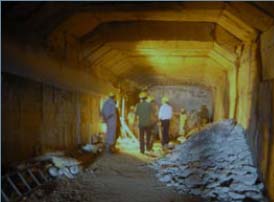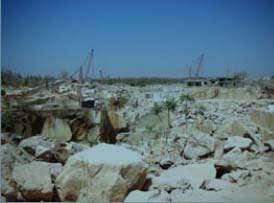 It does this in light of the recommendations of the Anwarul Hoda Committee, a High Level Committee set up by the Planning Commission in 2005. The draft SDF prepared by ERM India Pvt. Ltd. for the Ministry of Mines was released recently for seeking public comments before its formal adoption. It presents a set of guiding principles for the mining sector in India, which aims at achieving resource efficiency, business viability and environment stewardship around development of affected communities.
It does this in light of the recommendations of the Anwarul Hoda Committee, a High Level Committee set up by the Planning Commission in 2005. The draft SDF prepared by ERM India Pvt. Ltd. for the Ministry of Mines was released recently for seeking public comments before its formal adoption. It presents a set of guiding principles for the mining sector in India, which aims at achieving resource efficiency, business viability and environment stewardship around development of affected communities.
Historically, the extraction of mineral reserves has always resulted in varying degrees of environmental resource degradation and social impacts, including displacement, all across the globe. The Indian mining sector has been facing severe criticism on several issues relating to its performance vis-à-vis sustainable development. It is faced with extreme reactions from the people as it not only displaces them and degrades the environment but strikes at the root of the cultural moorings of the people by ushering in a lifestyle, which they find difficult to cope with. While governments and companies continue to profit year after year, people who are uprooted and are at the receiving end of the adverse effects of mining activity are hardly consulted while planning and executing mining operations. They are expected to be satisfied with the one-time compensation package given to them, without having any stake in share of the taxes, royalties or other benefits accruing from exploitation of mineral resources.
The Hoda Committee reviewed the National Mineral Policy 1993 and recommended that apart from introducing best practices in implementation of environment management, there was also a need to take into account the global trends in sustainable development. It specifically studied the impact of mineral development with the need to develop principles in mining, best practices, and reporting standards which may be measured objectively. It recommended development of an SDF specially tailored to the Indian context taking into account the work done and being done by International Council of Mining and Metals and International Union for the Conservation of Nature and Natural Resources (IUCN). The SDF was to comprise principles, reporting initiatives and good practice guidelines.
apart from introducing best practices in implementation of environment management, there was also a need to take into account the global trends in sustainable development. It specifically studied the impact of mineral development with the need to develop principles in mining, best practices, and reporting standards which may be measured objectively. It recommended development of an SDF specially tailored to the Indian context taking into account the work done and being done by International Council of Mining and Metals and International Union for the Conservation of Nature and Natural Resources (IUCN). The SDF was to comprise principles, reporting initiatives and good practice guidelines.
The concept of SDF can be traced back to 2001 when the world’s leading multinational mining companies decided to go for a image makeover by promoting the organization - International Council on Mining and Metals which developed a social and environmental wish-list, the SDF, which its members were to comply with voluntarily. It was suggested that the civil society and the local community could use the SDF to drive mining companies and regulators for increased accountability and mining performance related disclosure.
According to the Ministry of Mines, the SDF framework presented by it is scalable (big, medium and small mines) as well as comprehensive in terms of covering the issues facing minor as well as major minerals. The key monitoring mechanism is of self reporting on SDF performance in addition to monitoring by regulatory agencies. In time, when the SDF becomes more institutionalised and entrenched, the Ministry of Mines would consider setting up of an independent monitoring body to monitor SDF performance of companies. The approach is expected to allow for players in the mining sector at different levels of performance to become compliant over a period of time and continue to improve thereafter. The approach anticipates the incorporation of some of the key elements not already in the regulatory regime to become law in the near future, raising the bar on the sector's performance in terms of sustainable development.
 The SDF framework outlines a working definition for sustainable development in the mining sector as - "Mining that is financially viable; socially responsible; environmentally, technically and scientifically sound; with a long term view of development; uses mineral resources optimally; and, ensures sustainable post-closure land uses. Also one based on creating long-term, genuine, mutually beneficial partnerships between government, communities and miners, based on integrity, cooperation and transparency".
The SDF framework outlines a working definition for sustainable development in the mining sector as - "Mining that is financially viable; socially responsible; environmentally, technically and scientifically sound; with a long term view of development; uses mineral resources optimally; and, ensures sustainable post-closure land uses. Also one based on creating long-term, genuine, mutually beneficial partnerships between government, communities and miners, based on integrity, cooperation and transparency".
Furthermore, the SDF has defined a set of eight principles, which taken as a whole help the sector move towards sustainable development –
- Incorporating environmental and social sensitivities in decisions on leases;
- Strategic assessment in key mining regions;
- Managing impacts at the mine level impact through sound management systems;
- Addressing land, resettlement and other social impacts
- Community engagement, benefit sharing and contribution to socio-economic development;
- Mine closure and post closure mining operations must prepare, manage and progressively work on a process for eventual mine closure;
- Ethical functioning and responsible business practices; and
- Assurance and reporting.
At the very least, the SDF provides guidance for the mining companies to improve performance on environmental and social aspects. However, over time it can also become the common benchmark against which all mining operations may be evaluated in terms of their comparative performance on sustainable development terms.
The SDF will need to be used by mining companies to demonstrate commitment to sustainable development, and may be submitted to regulators at the time of seeking clearance or renewal or extension. It should also be used by regulators to evaluate the mining company's commitment to achieving environmental and social goals. Investors and financers may use this to assess risk and could additionally use it to demand better performance of the associated mining operations. Once this SDF is accepted, its use can be determined through more focused consultations and seeking consensus.
The process of driving the SDF will include several initiatives:
- Inclusion of some elements of the SDF into regulation;
- Inter-departmental cooperation for jointly reviewing performance against the SDF; and
- Evaluating applications and bids using additional criteria from the SDF for environmental and other clearances.
It is expected that the industry could, over time, choose to drive the wider adoption of the SDF as demonstration of performance and commitment to sustainable development goals.
The SDF draft is being opposed by civil society groups on the grounds that the Ministry should have stipulated the requirement of protecting the rights of the Scheduled Tribes in the Fifth Schedule areas keeping in view the Supreme Court's Samata judgement. The broad, vague and qualitative nature of SDF allows companies to get away without contributing much to social, economic and institutional development of the affected communities. "The reporting and verification process is also farcical and companies can write what they want because the verifiers are paid by them. In India, mining companies are supposed to submit annual environmental audit reports and half-yearly progress reports on environment management plans. Given that this mandatory system has failed, it is unlikely that a voluntary one will help make mining sustainable.” (Chandra Bhushan, DTE, 2008)
The report submitted by ERM India Pvt. Ltd. to the Ministry of Mines (September 2010) as well as the draft report put up by the Ministry of Mines (June 2011) for comments can be downloaded below. Please find attached two other documents related to the SDF - (a) Base document by the Ministry of Mines on "Geoscience for Sustainable Development" and (b) Guidelines on Corporate Social Responsibility for Central Public Sector Enterprises".